Menus
- Light enduros in comparison test
- Beta Alp 200 with Suzuki engine
- Kawasaki KLX 250 with the highest weight
- Beta Alp 200 with the smallest displacement
- Comfortable Kawasaki KLX 250
- Montesa 4Ride is the only one without an electric starter
- Euro 4 and the consequences
- MOTORCYCLE test result
- Price comparison of light enduros
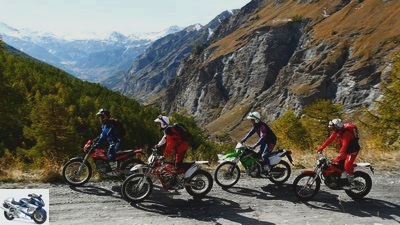
www.factstudio.de
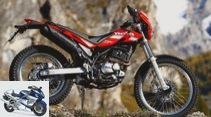
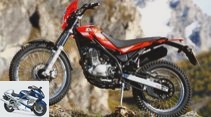
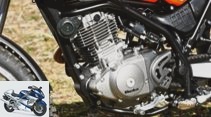
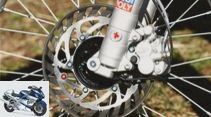
24 photos
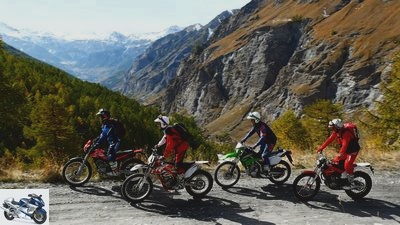
www.factstudio.de
1/24
Beta Alp 200, Kawasaki KLX 250, KTM Freeride 350 and Montesa 4Ride in comparison.
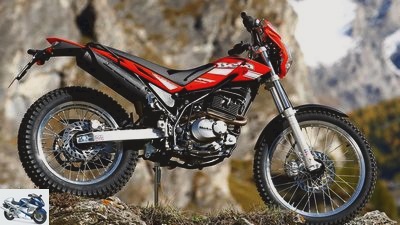
www.factstudio.de
2/24
Beta Alp 200.
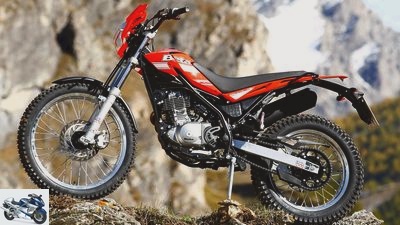
www.factstudio.de
3/24
Who invented it? Beta can claim to have initiated the hiking enduro concept in 1990.
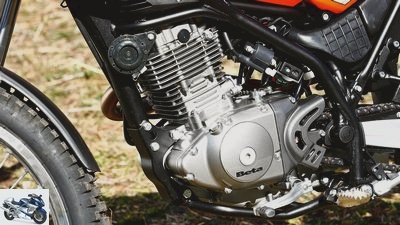
www.factstudio.de
4/24
Despite its origins in the trial segment, the Alp 200 with two-person approval, helmet lock and the air-cooled engine from Suzuki attaches great importance to everyday suitability.
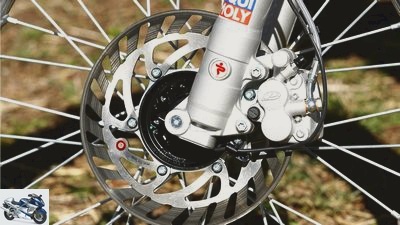
www.factstudio.de
5/24
Precisely for this reason, the poor front brake should be a bit more snappy.
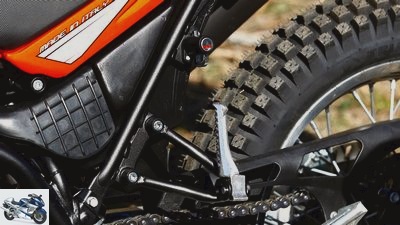
www.factstudio.de
6/24
Beta Alp 200.
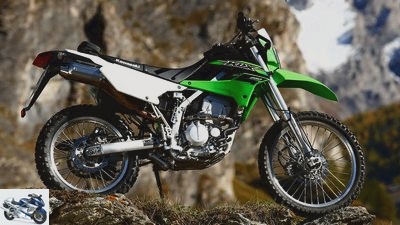
www.factstudio.de
7/24
Kawasaki KLX 250.
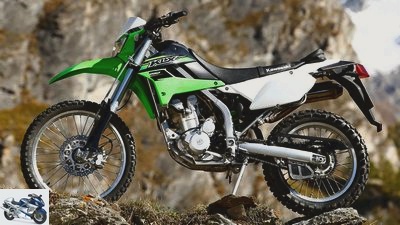
www.factstudio.de
8/24
Kawasaki KLX 250.
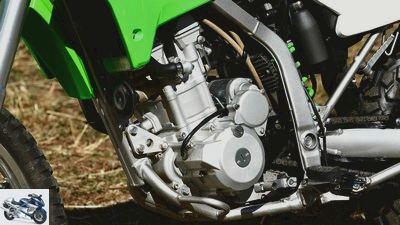
www.factstudio.de
9/24
Greenkeeper: With the KLX 250, Kawasaki appeals more to leisure endurance enthusiasts than enduro hikers.
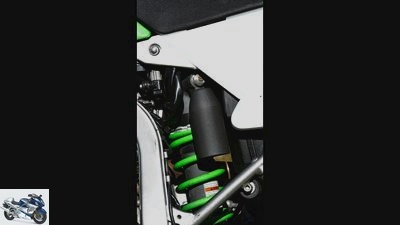
www.factstudio.de
10/24
The relatively high-quality chassis equipment (adjustable damping, upside-down fork) and the reliable dohc single…
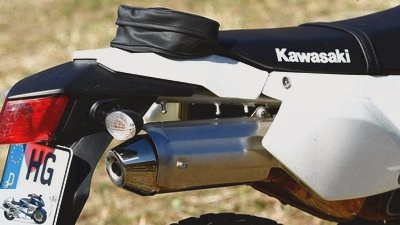
www.factstudio.de
11/24
… Liked as well as the moderate noise level.
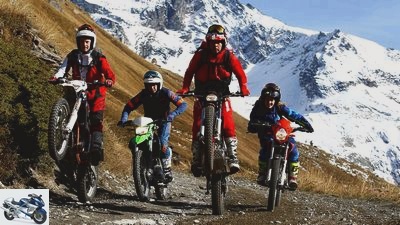
www.factstudio.de
12/24
Better to have a grand panorama than expensive technology. Wanderenduros shift the focus.
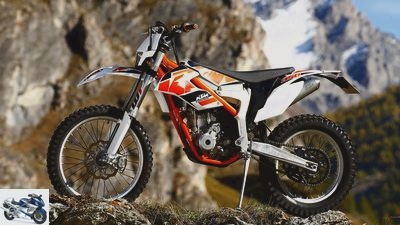
www.factstudio.de
13/24
KTM Freeride 350.
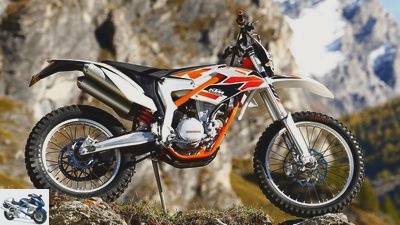
www.factstudio.de
14/24
KTM Freeride 350.
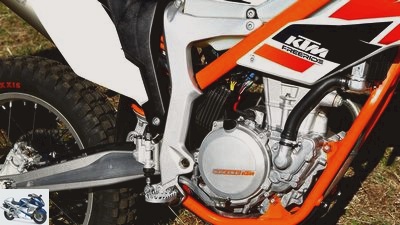
www.factstudio.de
15/24
Goat in orange: With the freeride, KTM not only appeals to enduro hikers, but also to off-road beginners.
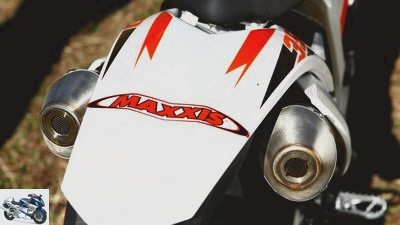
www.factstudio.de
16/24
The engine is based on the competition enduro 350 EXC-F, but is reduced to half of the original power in freeride – also due to the double silencers.
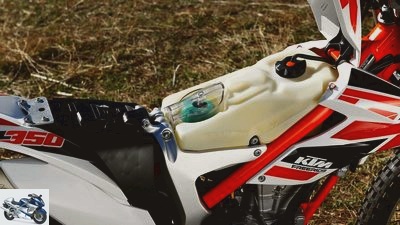
www.factstudio.de
17/24
5.5 liters of tank capacity are tight in the mountains
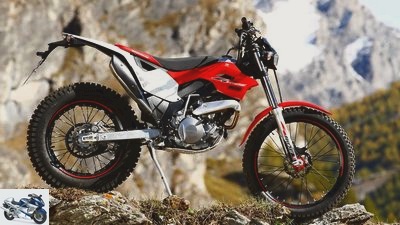
www.factstudio.de
18/24
Montesa 4Ride.
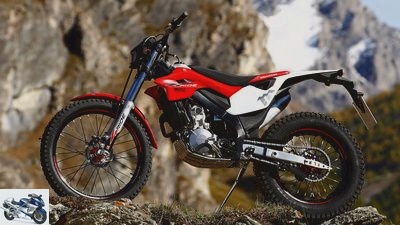
www.factstudio.de
19/24
The Montesa clearly shows its technical basis as a competition trialer.
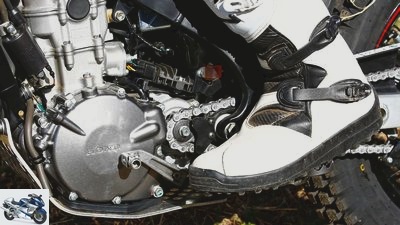
www.factstudio.de
20/24
The large distance from the footrest to the gearshift lever is already typical for trials, but unusual.
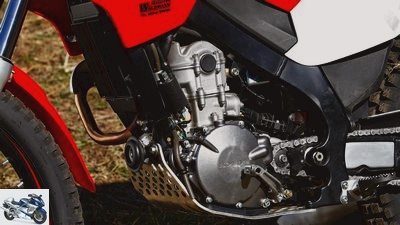
www.factstudio.de
21/24
The four-stroke single shines with pressure from the speed basement. But an electric starter is missing.

www.factstudio.de
22/24
Because of the tiny tank (4.4 liters), the reserve fuel fills most of the storage compartment on the mountain tour.
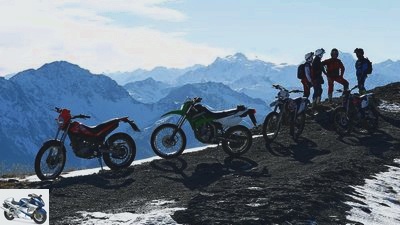
www.factstudio.de
23/24
Beta Alp 200, Kawasaki KLX 250, KTM Freeride 350 and Montesa 4Ride in comparison.
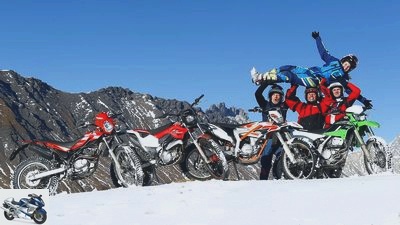
www.factstudio.de
24/24
Beta Alp 200, Kawasaki KLX 250, KTM Freeride 350 and Montesa 4Ride in comparison.
Beta Alp 200, Kawasaki KLX 250, KTM Freeride 350 and Montesa 4Ride
Light enduros in comparison test
With moderate volume and tires that are gentle on the ground, hiking enduro bikes promote gentle off-road tourism. The quiet ones open completely new horizons. Which light enduro looks best off-road? Beta Alp 200, Kawasaki KLX 250, KTM Freeride 350 or Montesa 4Ride?
On the Col de Sommeiller in November? Ivo Pirazzoli shows with the palm of his hand how deep the snow is up there. The man in his mid-fifties knows his way around and often chugs up in his old Suzuki DR 400 in the summer. The gravel road leads up to 2,996 meters, making it the highest pass in the Alps that can be legally driven. And we? Are late. But there was no other way. A lot of important things had to be done before the day of hiking. A symptomatic situation for the four lightweight enduro bikes Beta Alp 200, Kawasaki KLX 250, KTM F.reeride 350 and Montesa 4Ride. Because usually others are in the spotlight. Stronger, faster, more spectacular.
Buy complete article
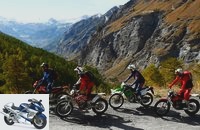
Beta Alp 200, Kawasaki KLX 250, KTM Freeride 350 and Montesa 4Ride
Light enduros in comparison test
KTM Freeride 350 and Montesa 4Ride at the same price
At first, the dirt path winds upwards, wide and smoothly pushed, bringing the slender quartet just up to operating temperature. Winfried sets the rhythm on the Honda. Sorry, on the Montesa 4Ride. The traditional brand from Barcelona has belonged to the Honda Group since 1985. Until recently machines like the Honda Varadero or Deauville were produced in the Catalan branch, now only the trial models roll off the assembly line. The only new product in the hiking enduro niche, the 4Ride presented this year, is based on their technology. It differs from its siblings in that its spring elements have a longer installation length (fork by 38 mm, strut by 12 mm), a wider gearbox, the tank that has been enlarged from 1.9 to 4.4 liters and a bench instead of the sparse plastic seat recess Basic models.
The Honda product planners may have taken a look at Austria. Because the population of hobby climbers is not that small. Since the KTM Freeride 350 was presented in 2012, the freirider has consistently been among the 100 best-selling motorcycles in this country. Certainly because not only hikers, but also enduro beginners are impressed by the uncomplicated nature of the tamed sports singles in the narrow hybrid frame – and at around 7,700 euros they also pay as much for them as for the Montesa 4Ride.
Beta Alp 200 with Suzuki engine
The Beta Alp 200 and Kawasaki KLX 250 (each around 4,700 euros) keep a respectable distance from this pecuniary demarcation line. Like the Montesa 4Ride, the Alp 200 approaches the idea of hiking from the trial-sport side. After all, she can proudly carry the air-cooled Suzuki engine between her frame tubes. After all, it was the Italians who launched the first alpine model in 1990 to promote gentle enduro tourism. The KLX 250 does not even try with an ideal superstructure. Since its presentation in 2009, the Kawa has been regarded as an uncomplicated bike – with its moderate volume and manageable dimensions, it represents the enduro-style low-budget counterpart to the KTM.
It’s a strange feeling when the goal isn’t the goal. We know that at some point the snow will block our ascent to the pass. Maybe that’s why nobody is in a hurry. Or is it the motorcycles? The interaction between machine and human is striking. Without annoying blaring and with effortlessly manageable performance, the quartet pushes us up in a relaxed manner. Of course one could also ask: How many emotions are still in play with a maximum of 23 hp? And wouldn’t have understood anything. Because you don’t need a dynamometer for the answer, but a keen eye for the grandiose landscape. Nevertheless, the technology also creates emotional differences.
The KTM Freeride 350 shows: Nobody needs more than 23 hp here. The dohc-Single starts cleanly after the bends, giving the driver the choice. Speed or torque? If in doubt, the latter. Because while his sports friend rotates up to 11,800 rpm in the 350 EXC-F, the quiet pedal locks off at 9,900 tours and pushes smoothly in the lower rev range. A good choice. Therefore, upshifts are usually made at what feels like 6,000 rpm. That’s enough.
Kawasaki KLX 250 with the highest weight
Like the Montesa 4Ride. The trial DNA appears to be poured into the single cylinder. The propellant, which works with battery-free injection, starts practically from idle and immediately encourages you to shift through the closely spaced transmission. The fact that – as is usual with trialers – the left foot has to be removed from the footrest mounted far back only bothers at the beginning. Instead, the clean running of the little engine inspires. The mechanical noise is minimal, the gearshift and clutch work precisely. Everything works very directly. Even the slightest turn of the throttle lifts the front over the repeatedly cross-running drainage channels. It couldn’t be easier. Only from the middle of the rev range does the 18 hp ohc single-cylinder breathe a bit shallowly, panting for the next higher gear to shine once more with its torque hill in the rev basement.
In contrast, the Kawasaki KLX 250 requires speeds. The more the better. You can intuitively cheer the 22 hp dohc single, but if in doubt, stay in the lower gear. Lifting the front over the washouts is only possible with a strong pull on the handlebars. Is it because of the highest weight in the field with 138 kilograms or the big jumps in the lower gears? Probably both. Instead of tingling mountain runners, the Kawa is more for the dignified hikers.
Beta Alp 200 with the smallest displacement
Like the Beta Alp 200. But not only the smallest displacement of the four with 199 cm³ makes the Italian sweat uphill. As the only stew still fed by a carburetor, the air-cooled single lacks the simplicity of the injection-fueled competition. A rough idle here, a short swallowing of the throttle there, the somewhat doughy gearshift there – compared to the Montesa propellant, the 15 hp Suzuki engine looks weak and as if from a bygone era. For orientation: The Alp 4.0, which is just 1,000 euros more expensive with the engine of the Suzuki DR 350, is far better in this regard.
Ivo suspected it. Winter knocks behind a few shady hairpin bends. The lanes pushed into the young snow by off-road vehicles are icy. Turn around now? After a driveway that could have been done with any big travel enduro. We remember a narrow junction. It’s worth a try. We screw our way back down the hairpin bends. Downhill, the drainage ditches are even more washed out and angular in the way than uphill. The KTM Freeride 350 and the Montesa 4Ride shine again. This time with a progressive suspension setup. While this has long been known from the WP spring elements of the freeride, the Montesa suspension combo, which is hardly known outside of the trial scene, is surprising. Both the conventional fork from the Italian specialist Tech and the monoshock from the Spanish manufacturer R16V respond sensitively and have enough reserves even with hard edges.
Comfortable Kawasaki KLX 250
In contrast to the brakes. After just a few sharp bends, the Braktec system, also produced in Spain, heats up and irritates with a muddy pressure point. This is likely to be due to the test field’s smallest front brake disc with a diameter of just 180 millimeters. The Beta Alp 200 doesn’t do any better in this respect either. The brake disappoints with high actuation force and moderate effect. Connoisseurs swap the Grimeca hand pump for a counterpart from Nissin (around 100 euros). But the suspension also needs rework. With moderate response and low reserves, the Beta Alp 200 bumps down the most uncomfortable of the quartet. What the driver of the Kawasaki KLX 250 can only smile about. At least at a walking pace, the fork and shock absorb every pothole without leaving any residue.
Besides, we see that we see almost nothing. The soft trial tires of the Beta Alp 200 and Montesa 4Ride and the slightly coarser treaded semi-trial tires of the KTM Freeride 350 hardly left any marks on the ascent. Only the imprints of the soft enduro skins of the Kawasaki KLX 250 (Dunlop D 605 G) can be read in the damp gravel.
Right now. An inconspicuous hiking trail leads over a stream to the opposite side of the valley and immediately climbs steeply. For GS and Co. this would be the end of the line. Good thing, now the hiking troop can prove themselves. The tighter the loops, the more the Kawasaki KLX 250 pilot works up a sweat. The relatively long first gear, the gentle pressure at lower speeds and the figure, which is chubby compared to 138 kilograms, add up to a relatively sedate character. Only those who keep the speed up with their finger on the clutch will rumble steadily upwards.
The driver of the Beta Alp 200 finds it easier. Central seating position, short translation. That fits. Only the waxy start in the lower engine speed causes uncertainty. It is not always possible to lift the front wheel over edges with one throttle. In case of doubt, it is better to choose the long line that maintains the momentum rather than the direct line. As a consolation, it sits at a height of 82 centimeters, at least 65 millimeters lower than the rest of the trio. This and the great grip of the buttery trial tires not only bring a large portion of safety back to 1.65 meter tall colleague Tanita.
Montesa 4Ride is the only one without an electric starter
But again it is the two upper class migrating birds who set the bar high here. The KTM Freeride 350 scrambles without any problems. Sit on it, accelerate, drive up. Foolproof may be the correct term for effortless ascent.
The Montesa needs a little trial time. But those who have got used to the easy front will find additional reserves compared to freeride. The trial competition tires (Dunlop D 803 GP) wrap around every rock edge like the suction cups on octopus arms, sucking up the feather-light 4Ride at 89 kilograms. Completely relaxed, Winni rolls past the waiting group on her, stops, folds the bench up, takes a bottle from the storage compartment – and refuel. Because with a meager 4.4 liters of fuel, the Montesa doesn’t make it 100 kilometers. Those who do not keep supplies will have to push for a long time. The fact that the Montesa 4Ride is the only one that does not have an electric starter does not really fit into the image of the high-priced hiking vacationer.
There are still three kilometers to the final ascent at the “Rifugio Scarfiotti”. We can see the snow-covered serpentines from afar. We turn around, circle down into the Susa valley and chug the last few meters on the country road to the guesthouse. Disappointed? On the contrary. Because the mission has not yet been completed. We will come back. Maybe with the next generation of hiking enduro bikes. But then definitely before November.
Euro 4 and the consequences
With the Euro 4 standard, which will apply from January 2017, the approval hurdle for the four tested hiking enduros has also increased. The new regulation has serious consequences.
The good news: Sport enduros and trialers are exempt from the ABS obligation that applies as part of the Euro 4 standard. The bad: There are no exceptions for enduro bikes when it comes to noise and exhaust emissions. For the Kawasaki KLX 250 and Beta Alp 200, which both do not meet the statutory criteria for trial or sport enduro machines, Euro 4 does not mean anything good. The Kawasaki KLX 250 will definitely be withdrawn from the range for 2017. Beta is not yet making any specific statements about the uncertain future of the Alp 200 and its 350 sister.
The KTM Freeride 350 is considered a competition enduro, but currently only has Euro 3 homologation. Euro 4 homologated freeride models are being planned and will be presented in the second half of 2017. The Montesa 4Ride is clear: all 2017 4Ride models are delivered in compliance with Euro 4.
MOTORCYCLE test result
www.factstudio.de
Beta Alp 200, Kawasaki KLX 250, KTM Freeride 350 and Montesa 4Ride in comparison
Beta Alp 200: It is small, handy, slim and not expensive. There are many reasons for the Beta Alp 200. But the weak-chested and still carburetor-fed Suzuki 200 engine reduces the fun of the nimble wanderer. The gloomy mood is not lightened by the weak brakes and the uncomfortable suspension. You can tell: the Alp is getting old.
KTM Freeride 350: KTM has set the tone with the freeride concept. Sufficient power, moderate noise and tires that are gentle on the terrain combine driving fun and environmental awareness. The KTM Freeride 350 also expands its target audience thanks to its sport enduro ergonomics. In addition to enduro hikers, off-road beginners in particular benefit from the unexcited character of the Austrian.
Kawasaki KLX 250: Conceptually, the Kawa is a bit on the sidelines. Because the KLX is more of an everyday than a hiking enduro. With comparatively comfortable accommodation and proven technology, it feels most comfortable on country roads and moderate country lanes. When the terrain becomes narrower or more difficult, the Kawasaki KLX 250 struggles with its weight and the somewhat tame engine in the lower rev range.
Montesa 4Ride: With the 4Ride, Montesa approaches the hiking enduro scene from a trial sport side. Anyone who gets used to the special ergonomics will be delighted. The flyweight, the beefy passage of the single and the trial competition tires hardly set any limits off the road. Typical for the Montesa parent company Honda: The processing quality is also right.
Price comparison of light enduros
Used light enduro bikes in Germany
The light enduros not only compete in the field, but also on the used motorcycle market. There they face each other in a direct price comparison: used light enduros in Germany
Related articles
-
Comparison test Kawasaki KLR 650-Yamaha XT 600 E.
fact comparison test Kawasaki KLR 650 / Yamaha XT 600 E Simple and poignant The XT 600 E brings back wistful memories of the great …
-
Jahn 35 pictures Jahn 1/35 Husqvarna TC 250 R in the motocross comparison test. Jahn 2/35 Yamaha YZ 250 F in the motocross comparison test. Jahn 3/35 Husqvarna TC …
-
Comparison test Suzuki SV 650, Honda CB 650 F, Kawasaki ER-6n, Yamaha MT-07
www.bilski-fotografie.de 34 pictures www.bilski-fotografie.de 1/34 They are the hottest candidates among the middle class naked bikes ….
-
Motocross Comparison Test – Honda, Kawasaki, KTM, Suzuki and Yamaha
Jahn 16 pictures Jahn 1/16 Kawasaki KX 450 F, KTM 350 SX-F, Yamaha YZ 450 F, KTM 450 SX-F, Suzuki RM-Z 450 and Honda CRF 450 R in the large MX1 (450cm³) …
-
Enduro comparison – off-road bikes from Beta, Honda, Yamaha and KTM
Monnich 24 pictures Monnich 1/24 With the Freeride 350, KTM is taking responsibility for the off-road scene. The competition: Yamaha WR 250 R, Honda CRF 250 L, …
-
Aprilia Tuono V4 1100 RR, Kawasaki Ninja H2 and BMW S 1000 XR in the comparison test
Arturo Rivas Gonzalez 31 photos Arturo Rivas Gonzalez 1/31 Aprilia Tuono V4 1100 RR, Kawasaki Ninja H2 and BMW S 1000 XR. Arturo Rivas Gonzalez 2/31 And…
-
Comparison test Harley-Davidson Fat Boy, Kawasaki 1500 VN, Yamaha XVZ 1300 A
Comparison test, Harley-Davidson Fat Boy, Kawasaki VN 1500 Classic, Yamaha XVZ 1300 A Royal Star Harley-Davidson Fat Boy, Kawasaki 1500 VN, Yamaha XVZ …
-
Ducati 1299 Panigale S and Kawasaki Ninja H2 in comparison test
31 pictures 1/31 Left in the picture 197 HP and 145 Nm (Ducati 1299 Panigale S), on the right there are 200 HP and 133 Nm (Kawasaki Ninja H2) ….
-
Comparison test between Kawasaki ZX-9R and Suzuki TL 1000 R
Comparison test between Kawasaki ZX-9R and Suzuki TL 1000 R How to take it? Finally: the Suzuki TL 1000 R wants to make V-twin fascination affordable. Two-…
-
Comparison test: Kawasaki KLX 250 against Yamaha WR 250 R
Comparative test: 250cc Enduro Kawasaki KLX 250 versus Yamaha WR 250 R Not everyone who likes to ride Enduro wants to get through the undergrowth in the fastest time …